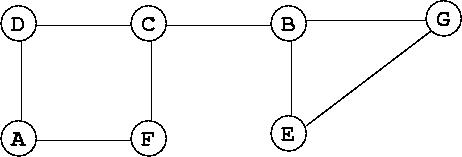COS 226 Homework #6
Due: Friday, April 8, 2005
Written Exercises
Follow the instructions on the assignments
page on how and when to turn these in. Point values of each problem are
shown in brackets. Be sure to also complete the programming part
of this assignment, including the program report.
Although the programming part of this assignment can be done with a partner,
these exercises, as well as the program report, must be completed and submitted individually
(as usual).
- [4] For the following graph, show the search tree (as in class)
that is induced by DFS, and list the vertices in the order in which they are
visited for the first time, starting from vertex A. Assume that you
iterate through the vertices adjacent to v in increasing order.

- [4] Repeat the last exercise for BFS. Also give the length
of the shortest path (number of edges) from vertex A to each other vertex.
- [4] For the following weighted graph, list the order in which edges are
added to the MST by Prim's algorithm, starting with vertex A.
What is the total weight of the MST that was found?

- [4] Repeat the last exercise for Kruskal's algorithm. What
is the total weight of the MST that was found?
- [10] (CLRS exercise 15-7,
slightly adapted)
Suppose you have one machine and a set of
N jobs
a1, a2,
..., aN to process on that machine. Each job
aj has a processing time
tj, a profit pj, and a
deadline dj. The machine can process only one
job at a time, and job aj must run
uninterruptedly for tj consecutive time
units. If job aj is completed by its deadline
dj, you receive a profit
pj, but if it is completed after its deadline, you receive a
profit of 0. Give a dynamic-programming algorithm to find the schedule that obtains the maximum
amount of profit, assuming that all processing times and deadlines are integers between 1 and
M. What is the running time of your algorithm?



